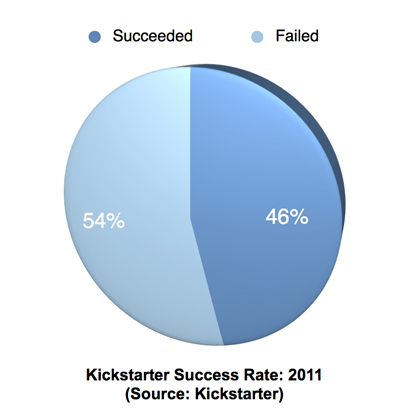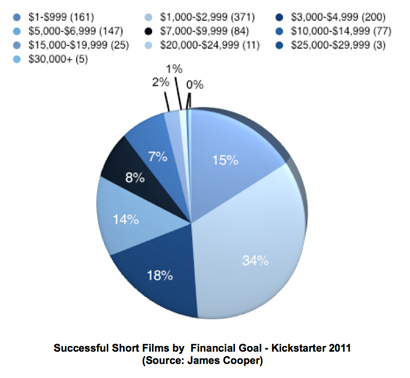James Cooper has written an eBook all about Kickstarter, compiling what he learned over the course of his own project. He’s kindly letting us reproduce some of it here for you. Look out for two more excerpts next week, and check out his book at www.kickstarterforfilmmakers.com
Kickstarter For Filmmakers
by James Cooper
Is crowd funding right for me and this project?
Seems simple, and probably a little obvious, but you’d be surprised by the number of campaigns that are launched without ever taking this into consideration. As I said before, crowd funding is not free money, and success isn’t made possible through the simple act of having a campaign. There are several questions to ask that will lead you to determine if you should be pursuing a crowd funding campaign or not:
Is the film interesting to people who aren’t working on it?
This is possibly the toughest question to ask, because people don’t like to consider the idea that they have a project that doesn’t really have an audience. Many filmmakers, are guilty of making films for themselves. This works when you’re footing the bill yourself, but when you’re looking for money from outside sources, you’re going to need elements that hook your potential audience. This may be a killer story, a unique way of making the film (stop motion, green screen, etc.), or noteworthy cast/crew (or anything else you can think of that makes your project stand out), etc. Preferably, you’ll have a combination of things.
The key here is to make sure you have a project that will catch not only the eyes of family and friends, but also their friends, people who follow you on Twitter, and complete strangers that may happen by your campaign by any of a hundred different ways. The longer crowd funding is around, the more widespread its usage becomes, and the easier it is to become lost in the shuffle. It hearkens back to the early 90’s independent film boom: when there were less people out there doing it, it was easier to get attention, but with the advent of digital technology and the numerous DIY solutions, there are so many filmmakers making low budget indies that it requires more and more to stand out. This is quickly becoming the case with crowd funding as well.
The significance of this question grows with your financial goals. As we saw in the statistics, the number of successful campaigns drops significantly every couple thousand dollars you climb, so you really have to take stock of your film as honestly as possible. If you must, ask friends who aren’t afraid to tell you what they really think: “If you didn’t know this was my project, would you be interested enough to put in a few bucks?”
Do I have a network/fan base capable of raising a majority of the funds required to hit my goal?
Assuming you answered the previous question with ‘yes’, now comes the next tricky question. You might have 1000 friends on Facebook and twice that in Twitter followers, but that isn’t necessarily what it takes to win the crowd funding war. As the old adage goes: it’s quality, not quantity. What that means in regards to your campaign is: yes, you might have 2000 Twitter followers, but how many are people you regularly interact with/ interact with you? How many are following what you do with an active interest? Additionally, the half of the question that’s even harder to accurately determine: how many of those are interested enough that they would toss a few bucks into a project you had? This goes back to “Is the film interesting to people who aren’t working on it?”

According to Kickstarter, they have a platform-wide success rate of 46%, which means you really need to be able to gauge the practicality of your campaign. This brings us to:
Is my goal realistic?
This is another tough one. Now you’ve determined you have a film people are interested in, and there are enough people interested in it that you think you can make an honest go of a crowd funding venture, but now you have to determine how much you think you can realistically raise.The higher your goal, the higher the risk you take that you may not hit it. In 2011, there were 1084 successful short film productions funded on Kickstarter, collectively representing $4,802,336 in pledges. Here’s a look at how they break down financially:

(these numbers strictly represent campaigns funding the film’s production costs)
The way these numbers break down is pretty interesting. We see that the $1,000 – $2,999 budget range easily dominates with 371 (34%) of the take, which is good news for anyone with a small(ish) budget short.
There’s a 46% drop between the number of successful projects in the $1,000 – $2,999 range and the $3,000 – $4,999 range, marking a distinct rise in difficulty of reaching success after only a couple thousand dollars more in the goal. This is definitely something you want to pay attention to if you’re unsure of if you want to go for that extra thousand or two. It might be a safer bet to aim lower and hope to over fund or search for the remaining funds elsewhere.Additionally, the drop when going from the $3,000 – $4,999 range to the $5,000 – $6,999 one is smaller: 27%. We take a steep 43% drop heading into the $7,000 – $9,999 range.
Now we enter the big money and the big risk. The percentage drops here are smaller than between earlier goal ranges, but only because the numbers we’re working with now are drastically smaller. If you’re gutsy enough to go after the five figures, here’s how they break down:
When you jump from $10k – $14.9k to the $15k – $19.9k bracket, there’s a drop of 68%. Then, when we jump from there to $20k-$24.9k there’s a 73% drop, with only 11 campaigns succeeding in this range.
Only three campaigns succeeded in the $25k-$29.9k bracket, with five managing to raise over $30,000. The most successful short film campaign in 2011 by a mile raised $82,000 of a $45,000 goal.
 Dropping out after a short stint at Toronto Film School in 2008, James pursued more pragmatic methods for developing his style and expanding his understanding of film language: making films.
Dropping out after a short stint at Toronto Film School in 2008, James pursued more pragmatic methods for developing his style and expanding his understanding of film language: making films. 




